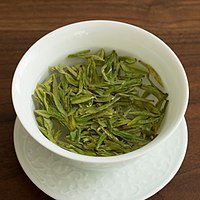Tea is an aromatic beverage commonly prepared by pouring hot or boiling water over cured leaves of the Camellia sinensis, an evergreen shrub (bush) native to Asia.[3] After water, it is the most widely consumed drink in the world.[4] There are many different types of tea; some, like Darjeeling and Chinese greens, have a cooling, slightly bitter, and astringent flavour,[5] while others have vastly different profiles that include sweet, nutty, floral or grassy notes.

Tea originated in Southwest China, where it was used as a medicinal drink.[6] It was popularized as a recreational drink during the Chinese Tang dynasty, and tea drinking spread to other East Asian countries. Portuguese priests and merchants introduced it to Europe during the 16th century.[7] During the 17th century, drinking tea became fashionable among Britons, who started large-scale production and commercialization of the plant in India to bypass the Chinese monopoly. Combined, China and India supplied 62% of the world's tea in 2016.
The term herbal tea refers to drinks not made from Camellia sinensis: infusions of fruit, leaves, or other parts of the plant, such as steeps of rosehip, chamomile, or rooibos. These are sometimes[8] called tisanes or herbal infusions to prevent confusion with tea made from the tea plant.